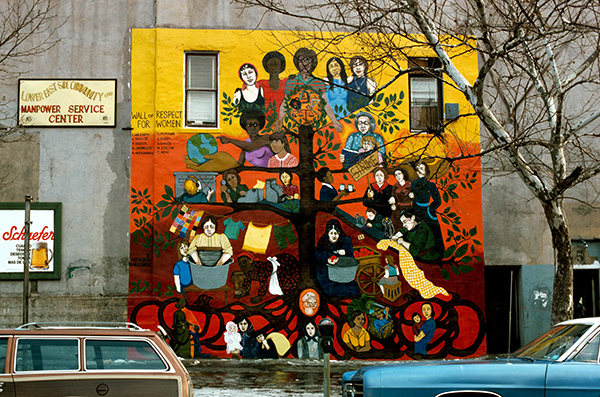AAPI Heritage Month 2022: Tomie Arai
Let’s start May with a tribute to Asian American and Pacific Islander Heritage Month. Throughout the month, the blog will focus on artists from those cultures who have had a major impact on American art.
 |
| CITYarts, Inc. (once Cityarts Workshop), Tomie Arai (lead artist, born 1949, U.S.), Wall of Respect for Women, 1974. Street art at East Broadway and Rutgers Street, New York. Image: Davis Art Images. (8S-20398) |
With the help of the two neighborhood artists—Susan Caruso-Green and James Januzzi—Cityarts Workshop artist Tomie Arai encouraged members of the community, children and adults, to participate in and feel invested in the beautification of their neighborhood through public art projects. With active participation by neighborhood women, Wall of Respect for Women emerged as the Cityarts visualization of the Women's Liberation movement.
Wall of Respect for Women was a joint project of Cityarts and nine working-class women from the Lower East Side of New York. The group reflected the multi-ethnic character of the community at the time: Chinese, Italian, Jewish, Puerto Rican, African American, and white. The underlying theme from the mural was "women's liberation," but it ended up be a statement about labor and the oppression of gender and race in the job market. The mural's location was a historical rallying place for women strikers in the early days of the labor union movement.
The original idea for Wall of Respect for Women was to depict women of all the neighborhood ethnicities in roles as doctors, lawyers, and teachers. This was deemed an unrealistic vision for the low-income neighborhood, and the women who participated in the mural decided to reflect the hard work and sacrifice that they themselves experienced on a daily basis.
The Women's Liberation (feminist) and Civil Rights movements of the 1960s engendered a greater visibility of art that reflected the changing nature of American culture. Focused groups of artists arose such as the Feminist Art Program (1971, California) and the Black artist collective Spiral (1963). Out of the charged atmosphere of social awareness combined with expression of those ideas through art, the American Mural Movement was born.
The mural movement in the U.S. was influenced by the post-Mexican Revolution (1910–1920) Mexican Mural Movement of 50 years earlier. The goal of the American public art movement was to vocalize social and political concerns pictorially, enhance depressed neighborhoods with beautiful art, and empower the members of those communities by encouraging their participation in mural projects. It has been variously called contemporary mural renaissance, people's art, or simply street art, and produced hundreds and hundreds of large-scale wall paintings in a dozen major U.S. cities and in Canada.
In New York, the artist Susan Shapiro-Kiok was asked to develop a creative arts workshop in a low-income neighborhood on the Lower East Side, founding the Cityarts Workshop in 1968. At the time, the Lower East Side was populated by Hispanics, African Americans, Asians, and poor whites. It was also home to a number of artists.
Enlisting the help of two artists who lived in the neighborhood, Shapiro-Kiok learned of the ethnic dynamics of the area that would inform the choices for mural subjects. She found that the struggle to maintain a decent standard of living for their families excluded any concern or even interest in visual arts, particularly in the rarified atmosphere of the museum and gallery "art world."
Realizing the New York art world did not address experiences of minorities, Arai participated in the Cityarts Workshop from 1972 to 1979. She began to pursue an art career in the late 1960s when America was on the cusp of social evolution in the African American, Hispanic, Women, and Asian empowerment movements. Arai has created public artworks around the U.S., incorporating stories and photographs from the community, collaborative processes, and printmaking techniques. In 2015, she cofounded The Chinatown Art Brigade, an interdisciplinary collective focused on giving voice to those affected by displacement and gentrification.
Correlations to Davis programs: The Visual Experience 4E: 11.9; A Community Connection 2E: 7.1, 8.4; A Global Pursuit 2E: 3.1; Experience Painting: p. 205–211


Comments